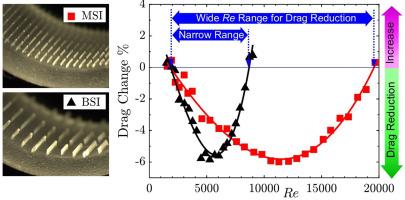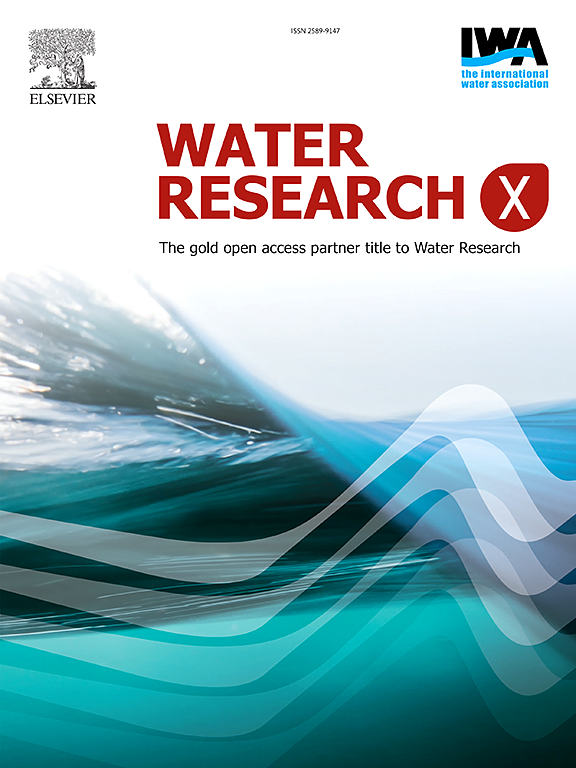Shark-inspired riblet design and optimization for drag reduction in drinking water distribution pipes across varying flow rates
IF 8.2
2区 环境科学与生态学
Q1 ENGINEERING, ENVIRONMENTAL
引用次数: 0
Abstract
Drinking water distribution systems (DWDS) experience significant energy losses due to turbulence-induced drag. While shark-inspired riblet surfaces have been shown to reduce drag in controlled conditions, their effectiveness in DWDS remains uncertain, particularly under the dynamic flow variations. This experimental study explores biomimetic riblet designs as a potential solution for drag reduction in such environments. Two riblet configurations were evaluated: one designed after the shortfin mako shark (MSI), with smaller, tightly spaced riblets, and another based on the blacktip shark (BSI), with larger, widely spaced riblets. Riblet structures were 3D-printed and tested in a water flow loop system. The results show that although MSI and BSI achieved similar maximum drag reduction of approximately 6 % near a nondimensional spacing of s⁺ ≈ 14.5, their performance differed significantly versus Reynolds numbers. The MSI design sustained drag reduction over a wider range (2500 < Re < 20,000), while the BSI design was effective only within 2500 < Re < 8500. However, beyond these ranges, both designs began to experience drag increase. In addition, a comparison of geometric descriptors revealed that the square root of the groove cross-sectional area (), provided the most consistent predictor for optimal riblet performance in pipe flow. However, the mean optimal value of was approximately 8.45, which is lower than the reference value of 10.7 reported for channel flows. This deviation likely results from confinement and curvature effects in pipe geometries, which modify vortex–riblet interactions compared to planar flows. These findings highlight the need to tailor riblet design to pipe-specific conditions and show that combining geometric and flow parameters improves performance evaluation in DWDS.

鲨鱼启发的波纹设计和优化,减少了不同流速下饮用水分配管道的阻力
由于湍流引起的阻力,饮用水分配系统(DWDS)经历了巨大的能量损失。虽然鲨鱼纹表面在受控条件下可以减少阻力,但其在DWDS中的有效性仍然不确定,特别是在动态流动变化的情况下。这项实验研究探索了仿生波纹设计作为在这种环境中减少阻力的潜在解决方案。评估了两种肋骨配置:一种是根据短鳍鲭鲨(MSI)设计的,具有较小的,紧密间隔的肋骨,另一种是根据黑鳍鲨(BSI)设计的,具有较大的,广泛间隔的肋骨。波纹结构是3d打印的,并在水流循环系统中进行了测试。结果表明,尽管MSI和BSI在s +≈14.5的无量纲间距附近实现了相似的最大减阻约6%,但它们的性能与雷诺数有显著差异。MSI设计在更大的范围内(2500 < Re < 20,000)持续减少阻力,而BSI设计仅在2500 <; Re <; 8500范围内有效。然而,超过这个范围,两种设计都开始经历阻力增加。此外,几何描述符的比较表明,槽横截面积的平方根(lg+)提供了最一致的预测器,用于管道流动中最佳的波纹性能。然而,lg+的平均最优值约为8.45,低于通道流的参考值10.7。这种偏差可能是由于管道几何形状的限制和曲率效应造成的,与平面流动相比,它们改变了涡纹相互作用。这些发现强调了针对管道特定条件定制纹管设计的必要性,并表明结合几何参数和流动参数可以改善DWDS的性能评估。
本文章由计算机程序翻译,如有差异,请以英文原文为准。
求助全文
约1分钟内获得全文
求助全文
来源期刊

Water Research X
Environmental Science-Water Science and Technology
CiteScore
12.30
自引率
1.30%
发文量
19
期刊介绍:
Water Research X is a sister journal of Water Research, which follows a Gold Open Access model. It focuses on publishing concise, letter-style research papers, visionary perspectives and editorials, as well as mini-reviews on emerging topics. The Journal invites contributions from researchers worldwide on various aspects of the science and technology related to the human impact on the water cycle, water quality, and its global management.
 求助内容:
求助内容: 应助结果提醒方式:
应助结果提醒方式:


